5 tips to designing the best shelter for your orchard
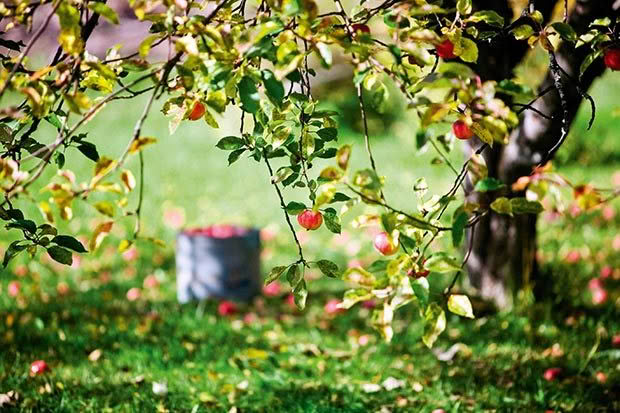
Sheltering your orchard is critical but that doesn’t mean they can’t be creative.
Words: Ben Gaia
Despite what you may see in some commercial fruit-growing areas of the country, the ideal orchard shelter is not a big square wall of pines, or large evergreens all around the paddock. This leads to several problems:
• too much shade
• large trees that need topping and felling
• windthrow damage in the shelter trees
• extra frosts in winter
1. GO FOR WIND PROOF NOT TALL TREES
A good shelterbelt does not need to be tall trees. Less vigorous and huge, but strong, hardy, windproof trees like pittosporum, feijoa, broadleafs, olives, ake ake, and mahoe, or deciduous bushes, alder, beech, hornbeam, are preferable to pines. As they establish, top them at 2-3m and you will never need huge machinery to top them – just let them throw new growth up to say 4m and you easily prune them down to 2m.
2. PLANT EARLY
Shelter trees should be established even before the fruit trees go in – they can warm the orchard by up to 5°C, and save foliage and blossoms from being stripped by high winds.
3. PLANT A RIGHT ANGLE…
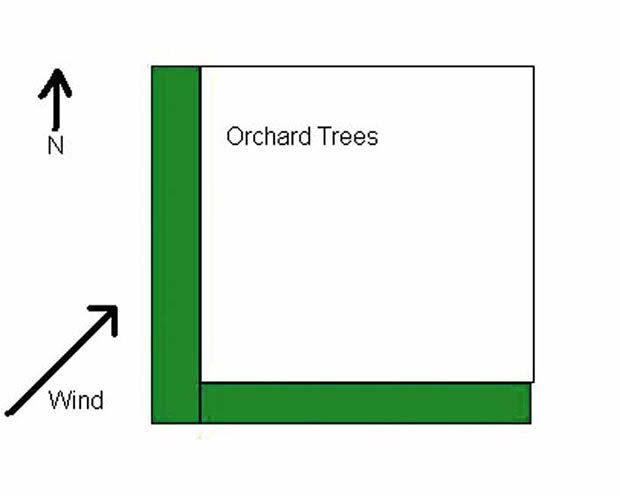
The minimum shelter you should consider is to plant two walls that meet as a corner facing the prevailing wind corner. At left is a plan of a minimum prevailing wind shelter for south westerlies, shaped like a ship’s prow.
3a. …OR PLANT RIGHT AROUND
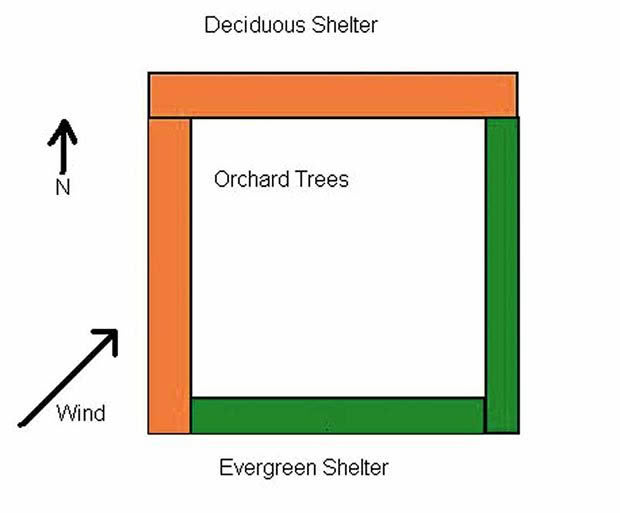
However, if you also get nor’ westers you will need shelter from the north too. This may seem a problem because you want to let the sun into the orchard in both winter and summer. The answer is low deciduous shelter all round the block for all other winds and frost but leave the north and west sides more open with lower bushes and deciduous species to let in winter sun, as well as summer sun to ripen fruit. The diagram at right shows a theoretical simple design for a square paddock using these principles. Another logical shape is a “U” shape of shelter open to the north, letting the sun in through the middle of the day but protecting the trees on the three other sides.
4. GO FOR WIDTH
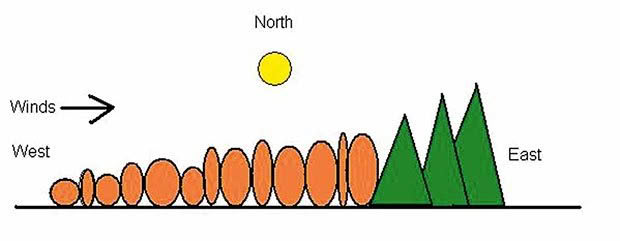
The diagram above shows a theoretical cross-section of orchard shelter from west to east. Low, mixed deciduous shelter lifts the wind. These low hedges are on the sunny (afternoon) side of the fruit trees, (north and west) rising to the highest evergreen shelter on the cold (morning) southern and eastern sides. A taller, evergreen shelter belt breaks the night time easterly winter winds off the snow and acts as a warm wall behind the trees during the day.
5. PERMACULTURE HEDGING
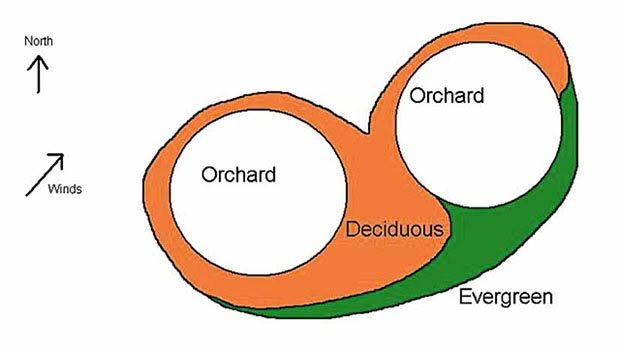
Follow the sweep of the land and get creative and you can take your shelter design outside the square box to produce a design like the one in the diagram below. This is a permaculture-style design ideal shaped like a “U” and facing north-west, as the afternoon sun is warmer. Evergreen trees form the tall wall protecting from those Antarctic and Dunedin winds. Curves of deciduous shelter let in the light on balmy winter afternoons and for summer ripening of fruit, but still shelter the orchard from all sides. The curves also direct winds around the block rather than interrupting them with a jolt. Bare twigs in winter filter the wind, muddling and slowing it without blowing down the tree.
BEN’S TIPS: GO RANDOM
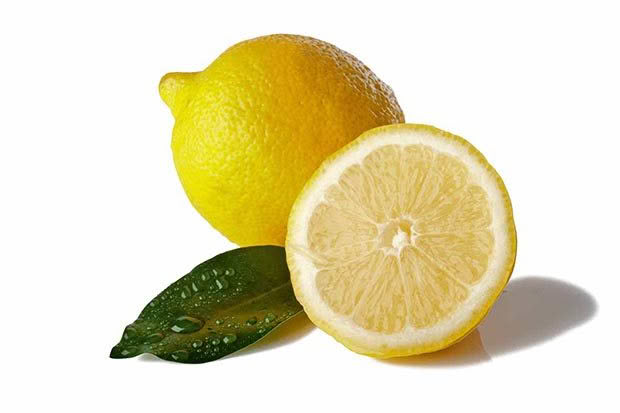
Another effective shelter style is to keep other trees dotted through the whole orchard. Pongas, deciduous shrubs, dare I say gorse or flax? There’s also no reason your shelter belt should not also be edible. Other options include:
• large seedling pears and/or apple trees, pruned or left to grow large
• cabbage trees in a stand
• flowering legumes for bee fodder which also boost pollination and soil nitrogen
• deciduous trees to feed the soil with leaf fall and allow winter light in
• cropping trees like hazelnuts or feijoas.
About the author
Ben Gaia grows trees in the extreme climate of the West Coast of the South Island and runs a mail order nursery for organic fruit and forestry trees, www.dialatree.co.nz
Love this story? Subscribe now!
 This article first appeared in NZ Lifestyle Block Magazine.
This article first appeared in NZ Lifestyle Block Magazine.
